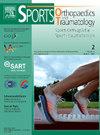Fibulare Bandrupturen im Kindesalter: Häufige Sportverletzung, praxisnahe Diagnostik, ultraschallgesicherte Therapie
Q4 Health Professions
引用次数: 0
Abstract
Einleitung
Auch im Kindesalter müssen fibulare Bandverletzungen frühzeitig exakt abgeklärt werden. Die klinische und radiologische Untersuchung reichen nicht allein aus.
Material und Methode
Alle akuten Sprunggelenksdistorsionen der Praxis unter 18 Lebensjahren wurden klinisch und sonografisch untersucht und nach 4–5 Wochen konservativer Therapie kontrolliert.
Ergebnisse
140 Kinder (87 m, 53 w, Ø-Alter 10,9 (5–17) Jahre) aus 442 Sprunggelenksdistorsionen (=33,2%) hatten sich sonografisch gesicherte Sprunggelenksbandrupturen zugezogen (Inzidenz 0,88%): 82 knöcherne LFTA-Verletzungen (58.6%), Ø-Alter 9,3 (5–15) Jahre) mit 6mal leichter und 2mal deutlicher Instabilität (9,8%); 44 ligamentäre LFTA-Risse (31,4%), Ø-Alter 13,4 Jahre (6–16 J) mit 20mal leichter und 4mal deutlicher Instabilität (54,5%), 9 CC-Gelenksverletzungen, 4 Syndesmosenläsionen und 1 Salter-Harris-I-Verletzung der Außenknöchelfuge. 24mal fand sich bei knöcherner Avulsion kein radiologisches Korrelat. Die Genauigkeit der klinischen Stabilitätsdiagnostik im Vergleich zur Sonografie liegt für alle Distorsionen bei 34,8%. Für die sonografische versus klinische Stabilitätstestung ergibt sich eine Sensitivität von 85,7% und eine Spezifität von 99%. 110/126 LFTA-Verletzungen wurden nachuntersucht: keine Schmerzen, volle Belastungsfähigkeit und Beweglichkeit, 2 leichte Instabilitäten bei knöcherner Läsion (2,9%), 4 nach ligamentärer Verletzung (10,3%).
Zusammenfassung
Stabile knöcherne fibulare Avulsionen sind das typische Verletzungsbild bei Kindern unter 12 Jahren, bei älteren Kindern überwiegen ligamentäre Rissformen mit meist leichtgradiger akuter Instabilität. Ohne Sonografie wird das Vorliegen relevanter Bandverletzungen unterschätzt. Sie ist daher als primäre Bildgebung zu empfehlen. Restinstabilitäten oder Rezidive sind Raritäten.
Background
Early exact diagnosis of pediatric lateral ankle ligament tears is mandatory. Clinical and radiological examinations alone are not sufficient.
Material and methods
All acute ankle sprains under 18 years were examined clinically, sonographically and controlled after 4–5 weeks of conservative treatment.
Results
140 children (87 m, 53 w, Ø age 10.9 (5–17) years) out of 442 ankle sprains (=33.2%) sustained ankle ligament tears verified by ultrasound (incidence 0.88%): 82 osseous AFTL-lesions (58.6%), Ø age 9.3 (5–15) y, 6 minor, 2 marked instabilities (9.8%), 44 ligamentous ATFL tears (31.4%), Ø age 13.4 (6–16) y, 20 minor and 4 marked instabilities (54.4%), 9 CC joint lesions, 4 ATFL lesions and 1 Salter-Harris-I-injury of the distal fibula. In 24 of the osseous avulsions no radiological correlation could be found. Clinical vs ultrasound stress testing of all ankles sprains yields an accuracy of 34.8%. Sonographic compared to clinical stress testing yields a sensitivity of 85.7% and a specifity of 99%. 110/126 ATFL lesions could be followed-up: no pain, full load and mobility, 2 minor instabilities in osseous avulsions (2.9%), 4 after ligamentous tears (10.3%).
Conclusions
Stable bony avulsion tears form the typical pediatric injury pattern under 12 years, whereas older children display ligamentous tears with minor instability. Without sonography the existence of a relevant ligament injury seems to be underestimated. Ultrasound therefore is recommended as primary imaging diagnostics. Resting instabilities or recurrent injuries are rare.
儿童胸骨骨折:常见运动损伤,实用诊断,超声治疗
即使在儿童时期,腓骨带损伤也必须在早期得到准确的诊断。光有临床和放射检查是不够的。材料和方法对18岁以下的所有急性关节畸形进行临床和超声检查,并在保守治疗4-5周后进行控制。结果140名儿童(87 m, 53 w, Ø-年龄10.9(5-17)岁),442个膝关节畸形(= 33.2%),经超声检查的膝关节韧带断裂(发生率0.88%):82个骨LFTA损伤(58.6%),Ø-年龄9.3(5-15)岁),6倍容易,2倍明显不稳定(9.8%);44处韧带LFTA骨折(31.4%),Ø-年龄13.4年(6-16岁),轻度20倍,明显不稳定性4倍(54.5%),9处CC关节损伤,4处综合征损伤和1处Salter-Harris I外踝缝损伤。与超声检查相比,所有畸变的临床稳定性诊断准确率为34.8%。超声与临床稳定性试验的灵敏度为85.7%,特异性为99%。110/126例LFTA损伤的随访:无疼痛,完全应变和灵活性,2例骨骼损伤轻微不稳定性(2.9%),4例韧带损伤后不稳定性(10.3%)。稳定骨腓骨脓肿是12岁以下儿童的典型病变,韧带断裂在年龄较大的儿童中占主导地位,通常轻度急性不稳定。没有超声检查,相关带状损伤的存在被低估了。因此,建议将其作为主要图像。不稳定或复发是罕见的。儿科踝关节外侧韧带撕裂的早期准确诊断是强制性的。临床和放射检查是不够的。材料和方法18岁以下所有急性踝关节扭伤在保守治疗4-5周后进行临床检查、超声和控制。Results140儿童(87米,53 wØ天10.9 (5-17)years)远离442 ankle sprains (= 33.2%) sustained ankle ligament tears verified ultrasound赞助(incidence 0.88%): 82 osseous AFTL-lesions(58.6%),Ø天9.3 (5-15)y, 6 minor, 2 marked instabilities (9.8%), 44 ligamentous ATFL tears(31.4%)、Ø天13.4 (6-16)y, 20 minor、四台marked instabilities(54.4%)、9 CC lesions,联合4 ATFL lesions and 1《Salter-Harris-I-injury distal腓骨.在24例骨病变中,没有发现放射学相关性。所有踝关节扭伤的临床vs超声压力测试的准确率为34.8%。与临床压力测试相比,超声检查的敏感性为85.7%,特异性为99%。110/126 ATFL损伤可随访:无疼痛、满负荷和活动能力,2例骨挫伤轻微不稳定(2.9%),4例韧带撕裂(10.3%)。结论:12岁以下儿童骨浸润性撕裂形成典型的儿科损伤模式,年龄较大的儿童表现出轻微不稳定的韧带撕裂。如果没有超声检查,相关韧带损伤的存在似乎被忽视了。因此,超声被推荐作为主要的成像诊断。不稳定或复发损伤是罕见的。
本文章由计算机程序翻译,如有差异,请以英文原文为准。
求助全文
约1分钟内获得全文
求助全文
来源期刊

Sports Orthopaedics and Traumatology
Health Professions-Physical Therapy, Sports Therapy and Rehabilitation
CiteScore
0.70
自引率
0.00%
发文量
145
审稿时长
43 days
 求助内容:
求助内容: 应助结果提醒方式:
应助结果提醒方式:


